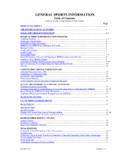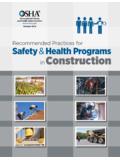Transcription of TECHNICAL DOCUMENT GUIDELINES ON METALS …
1 COUNCIL OF EUROPE S POLICY STATEMENTS CONCERNING MATERIALS AND ARTICLES INTENDED TO COME INTO CONTACT WITH FOODSTUFFS POLICY STATEMENT CONCERNING METALS AND alloys TECHNICAL DOCUMENT GUIDELINES ON METALS AND alloys USED AS FOOD CONTACT MATERIALS ( ) 2 TECHNICAL DOCUMENT GUIDELINES ON METALS AND alloys USED AS FOOD CONTACT MATERIALS 3 NOTE TO THE READER The GUIDELINES on METALS and alloys used as food contact materials are part of the Council of Europe s policy statements concerning materials and articles intended to come into contact with foodstuffs. The present DOCUMENT may be consulted on the Internet website of the Partial Agreement Department in the Social and Public Health Field: For further information, please contact: Dr Peter Baum Partial Agreement Department in the Social and Public Health Field Council of Europe Avenue de l Europe F-67000 Strasbourg Tel.
2 +33 (0)3 88 41 21 76 E-mail: Fax +33 (0)3 88 41 27 32 4 TABLE OF CONTENTS Page Part I - Council of Europe and food contact materials 1. Council of 7 2. The Partial Agreement in the social and public health field .. 7 3. Council of Europe Committees in the public health field .. 8 4. Terms of reference of the Committee of experts on materials coming into contact with 9 5. Main tasks of the Committee of experts on materials coming into contact with 10 Part II - GUIDELINES on METALS and alloys used as food contact materials General GUIDELINES 1. Introduction ..13 2. Legal status of these GUIDELINES and their update .. 13 3. Field of application.
3 14 4. General requirements and recommendations .. 16 Specific GUIDELINES Aluminium ..23 Chromium ..27 Copper ..31 Iron .. 35 37 Manganese .. 41 Nickel .. 43 Silver .. 47 Tin .. 49 5 Specific GUIDELINES Titanium .. 53 Zinc .. 55 alloys other than stainless steel .. 57 Stainless steel .. 61 Appendix l Metallic elements found as contaminants and impurities ..67 Cadmium .. 69 Cobalt .. 73 Mercury .. 75 Appendix II Comparision of the intakes of selected METALS with their PTWI .. 77 Appendix III Natural elements content of foodstuffs .. 81 6 PART I COUNCIL OF EUROPE AND FOOD CONTACT MATERIALS 1. Council of Europe The Council of Europe is a political organisation which was founded on 5 May 1949 by ten European countries in order to promote greater unity between its members.
4 It now numbers 43 member States1. The main aims of the Organisation are to reinforce democracy, human rights and the rule of law and to develop common responses to political, social, cultural and legal challenges in its member States. Since 1989 the Council of Europe has integrated most of the countries of Central and Eastern Europe into its structures and supported them in their efforts to implement and consolidate their political, legal and administrative reforms. The work of the Council of Europe has led, to date, to the adoption of over 170 European conventions and agreements, which create the basis for a common legal space in Europe.
5 They include the European Convention on Human Rights (1950), the European Cultural Convention (1954), the European Social Charter (1961), the European Convention on the Prevention of Torture (1987) and the Convention on Human Rights and Bioethics (1997). Numerous recommendations and resolutions of the Committee of Ministers propose policy GUIDELINES for national governments. The Council of Europe has its permanent headquarters in Strasbourg (France). By statute, it has two constituent organs: the Committee of Ministers, composed of the Ministers of Foreign Affairs of the 43 member States, and the Parliamentary Assembly, comprising delegations from the 43 national parliaments.
6 The Congress of Local and Regional Authorities of Europe represents the entities of local and regional self-government within the member States. A multinational European Secretariat serves these bodies and the intergovernmental committees. 2. The Partial Agreement in the social and public health field Where a lesser number of member states of the Council of Europe wish to engage in some action in which not all their European partners desire to join, they can conclude a Partial Agreement which is binding on themselves alone. The Partial Agreement in the social and public health field was concluded on this basis in 1959.
7 The areas of activity of the Partial Agreement in the social and public health field include two sectors: Protection of public health Rehabilitation and integration of people with disabilities. 1 Albania, Andorra, Armenia, Austria, Azerbaijan, Belgium, Bulgaria, Croatia, Cyprus, Czech Republic, Denmark, Estonia, Finland, France, Georgia, Germany, Greece, Hungary, Iceland, Ireland, Italy, Latvia, Liechtenstein, Lithuania, Luxembourg, Malta, Moldova, The Netherlands, Norway, Poland, Portugal, Romania, Russian Federation, San Marino, Slovak Republic, Slovenia, Spain, Sweden, Switzerland, "the former Yugoslav Republic of Macedonia", Turkey, Ukraine, United Kingdom of Great Britain and Northern Ireland.
8 7At present, the Partial Agreement in the public health field has 18 member states1. The activities are entrusted to committees of experts, which are responsible to a steering committee for each area. The work of the Partial Agreement committees occasionally results in the elaboration of conventions or agreements. The more usual outcome is the drawing-up of resolutions of member states, adopted by the Committee of Ministers. The resolutions should be considered as statements of policy for national policy-makers. Governments have actively participated in their formulation. The delegates to the Partial Agreement committees are both experts in the field in question and responsible for the implementation of government policy in their national ministries.
9 The procedure provides for considerable flexibility in that any state may reserve its position on a given point without thereby preventing the others from going ahead with what they consider appropriate. Another advantage is that the resolutions are readily susceptible to amendment should the need arise. Governments are furthermore called upon periodically to report on the implementation of the recommended measures. A less formal procedure is the elaboration of TECHNICAL documents intended to serve as models for member states and industry. Bodies of the Partial Agreement in the social and public health field enjoy close co-operation with equivalent bodies in other international institutions, in particular the Commission of the European Union.
10 Contact is also maintained with international non-governmental organisations (NGOs) and industry, working in similar or related fields. 3. Council of Europe committees in the public health field Public Health Committee (Steering Committee) Committee of experts on materials coming into contact with food Ad hoc Groups of the Committee of experts: - Ad hoc Group on safety evaluation - Ad hoc Group on recycled fibres (with industry participation) - Ad hoc Group on test conditions for paper and board (with industry participation) - Ad hoc Group on tissue papers (with industry participation) - Ad hoc Group on packaging inks (with industry participation) - Ad hoc Group on coatings (with industry participation) - Ad hoc Group on cork (with industry participation) - Ad hoc Group on rubber (with industry participation) Committee of experts on nutrition, food safety and consumer health Ad hoc Groups of the Committee of experts.








